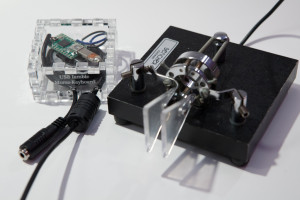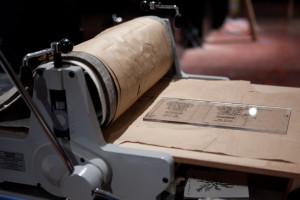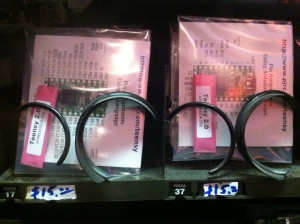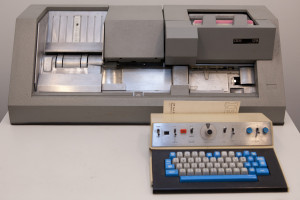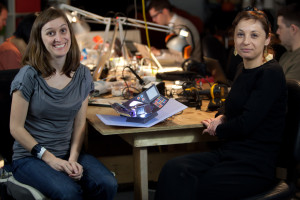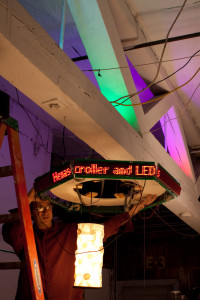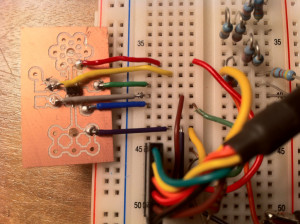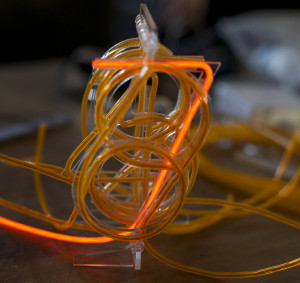While uploading a model to thingiverse, I noticed an ultra cute Cthulhu and had to print it immediately on the Makerbot at NYC Resistor. Then I had an idea that the same process that generates the gcode shells for the makerbot could be used to generate slices to be cut on the laser cutter.
Continue reading »
Morse code keyboard
Have you switched your QSOs to PSK31 or some other digital mode, but miss the joy of sending CW with an iambic paddle? Then here’s a project for you.
Continue reading »
Laser cut intaglio printing
Did you know that you can cut letter press relief or intaglio plates on the NYCR laser cutter? The laser cut acrylic holds a decent edge and is far less expensive than copper plate. Here is a short guide to how to make engraved invitations using the intaglio process:
Continue reading »
New in NYCR vending: Teensy 2.0
New in the NYCR vending machines are Teensy 2.0 boards. They have ATMega32U4 chips, which have the built in USB drivers and, via LUFA, can appear as any USB device, not just a serial communications device. Want to make a MIDI device show up as a USB keyboard? Or a core memory as a mass storage device? You can do that! The USB doesn’t consume a UART, so there is still a serial port available for interfacing with GPS or other external RS232 devices.
PJRC makes the Teensyduino plugin for the Arduino IDE and a set of compatible libraries so that you can use it with your Arduino sketches. Or you can drop into straight C and take full advantage of all of the AVR pins.
Update: They are very popular! Three were bought during Craftnight tonight.
IBM 129 Card Data Recorder
This weekend PMF and I cleaned an IBM 129 Card Data Recorder and were able to fairly reliably punch cards once we were done. When we started it would frequently jam during feeding, mis-feed during the punch, and not cleanly stack the cards in the output bin.
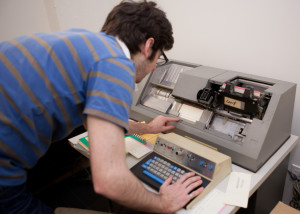
Most of the problem was thirty years of dust, card fiber and grime built up in the mechanisms. The output hopper was full of it and needed a good cleaning to reliably pick up cards into the output stack:
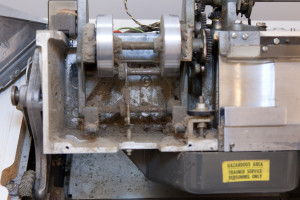
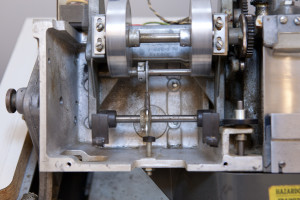
Tonight at 21:00 eastern (02:00 UTC) Make:Live’s Hackerspace roadshow II visits NYC Resistor and other hackerspaces. From NYC Resistor you’ll see Alicia, Catarina and Shelby’s electronic art book, Mimi’s RFID blocking wallets, Charles’ TV-B-Gone gun and other cool projects by NYCR members.
Continue reading »
Adam and I upgraded Hexascroller to control 5 m of Adafruit RGB LED strip through a spare serial port connected to a Teensy 2.0 that drives the strip via SPI. Now when a new message is displayed, the accent lights switch to a bright flashing mode to attract attention, then they will return to soothing, slow color changing mode.
Click the “Read more” to see additional photos of the installation and setup. Continue reading »
ATTiny10 programming
Using Darrel Tan’s Programming the ATTiny10 instructions and a SOT-23 breakout board by Raphael, I was able to flash one of these very small MCU chips. Given the small package, these programmable devices can be dropped just about anywhere on a circuit that a transistor would be used.
Unlike Tan, my FTDI breakout cable does not have DTR, so the reset pin on the chip needs to be pulled low manually to put it into programming mode, and the pinout adjusted. Full instructions after the break…
Continue reading »
Hex-curious?
Have you ever wondered how to make sense of hexdumps?
e1a02000e5d00000 e3500000012fff1e e3a00000e2800001 e7d23000e3530000 1afffffbe12fff1e
Or been curious to know what exactly does a bxeq lr instruction mean in assembly?
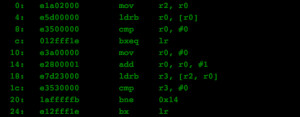
If so, then you should sign up for the introduction to assembly programming and reverse engineering class. You can learn assembly programming and machine architecture using reverse engineering techniques on your own code. In this class we will write code, compile it into an executable and then disassemble it to learn about registers, stacks, branches, function calls and argument passing, structs and other common idioms.
Experience with any programming language is required; the examples in the class with be in C, with dissassembly into ARM assembly. Bring your own laptop with arm-elf-gcc and associated binutils installed to follow along.
EL Wire “Nixie” tubes
Catarina helped me build a prototype of a “Nixie” tube illuminated with electroluminescent wire. Unfortunately the wires are too dense and too dim to work well with the ten layers of thickness, so the prototype is a beautiful failure. The number frames are based on Futura and cut on our Epilog laser using my opensource epilog driver. Side view and SVGs follow.
Continue reading »

